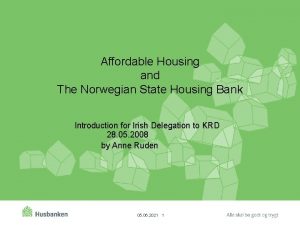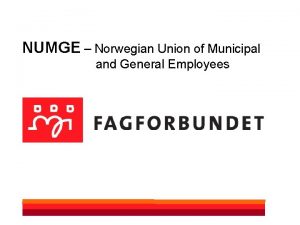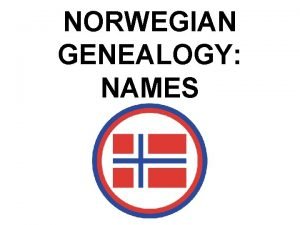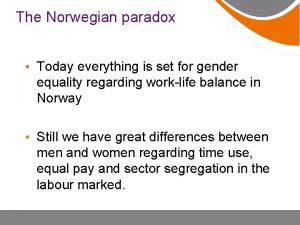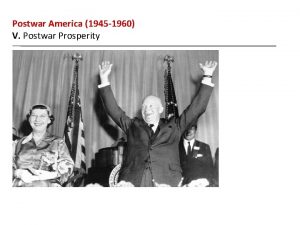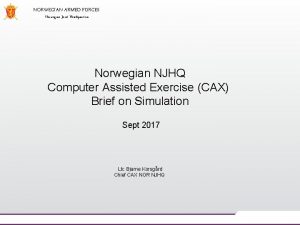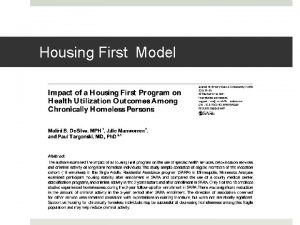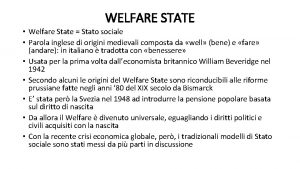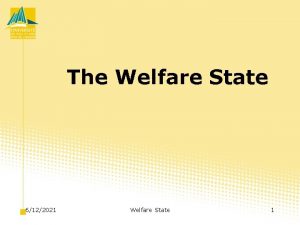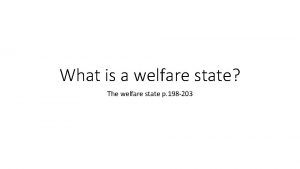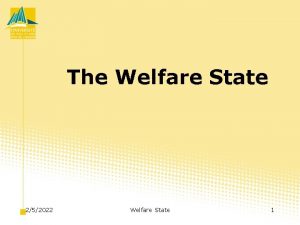The PostWar Norwegian Welfare State Housing Model and













- Slides: 13

The Post-War Norwegian Welfare State Housing Model and the Role of Housing Cooperatives Tore W. Kiøsterud Conference on Urbanization and Affordable Housing Oslo, 2 October 2017

Adequate and affordable housing for all

Main points • Framework: National Governance • Urban – Rural Balance Policy • Housing Policy • The system and it’s participants • Urbanization and housing cooperatives • Targets and the instruments • Achievements • Present challenges

A very brief history 1945 to 1980 1981 to present • Poor housing situation after WWII • Macro-economic Investment strategy; Priority to housing investment. • Regulation and rationing • State Investment Banks • The State Housing Bank • Liberalisation and deregulation • Increasing wealth • Oil revenue • Reduced role of state housing bank • More volatile housing market

National governance • A Macroeconomic strategy • Welfare objectives • Government legislation, budgets and planning • Mobilisation and utilization of people and natural resources • Investment

Urbanization of Norway- Regional policy • Urbanisation of Norway: Dependent of change in industrial structure, from agriculture, through manufacturing to services. Due to education and change in productivity-and oil and fish! • Regional policies to stabilise the geographic distribution of the population, through spesific sectoral means, subsidies and designated institutions • Investment policies, location of public institutions and private projects, housing loans and subsidies through the State Housing Bank

Housing Policy The system and its participants Local government Central government - - Land use - Social housing - Infrastructure Legislation Financing/ State Housing Bank Taxation Subsidies Housing cooperations Self-builders The household Building industry Investors

Urbanisation and Cooperatives • • • Housing cooperatives have played a dominant role in urban housing New cooperative housing were mainly financed by the State Housing Bank Democratic member organisations Private, but regulated by 2 laws since 1960 Price regulated up to the 1980 -es Substituted municipal housing • Cooperatives are both developers and owners: • Housing developers – Example OBOS since 1929 • Organisations of housing cooperatives – Owned by the inhabitants who are free to sell at market price.

Housing Policy – Targets and instruments • Targets for house building-up to the 1980 -es • Annual number of new houses: 40 000 per year in the 1970’s, 4 -year programmes • Standards: Set by minimum and maximum size of dwellings and cost ceilings • Housing cost: on average 20 percent of an average industrial wage • Municipal land banks- cost based pricing • State Housing Bank: General mortgage loans and needs tested equity loans , needs tested housing allowance • VAT-compensation up to 1980 • Interest deduction on income taxation

Achievements

Experiences • The investment strategy after the war and up to the 1980 s achieved its targets and ambitions: A great improvement in housing conditions for most of the population. • Owner –occupied detached housing and multy-family cooperative housing were main contributors. Totally 80 percent of stock. • Free-market housing based on private financing. Housing market more vulnerable and unstable. Bank and housing crises around 1990. • General housing conditions are good, little substandard housing, but owercrowding has been increasing, especially in the cities and for low-income groups, immigrants, young people and one parent families.

Present Challenges • The Norwegian Economy-from oil drilling to? The critical political economic challenge! • The impact of oil on housing and urbanisation? Wage level pushing, thus on cost and demand of housing. • Urbanisation; oil-relevant job location along the coast

Present Challenges • SDG 11 and NUA-implementation • Housing price increase, access to adequate and affordable housing • The dependence on the distribution of income and wealth; • Young people-students • Elderly people • Immigrants • Low-income households
 Norwegian state housing bank
Norwegian state housing bank Norwegian cyclone model
Norwegian cyclone model Norwegian cyclone model
Norwegian cyclone model Pros and cons of welfare
Pros and cons of welfare Norwegian union of municipal and general employees
Norwegian union of municipal and general employees Norwegian museum of science and technology
Norwegian museum of science and technology Norwegian directorate for education and training
Norwegian directorate for education and training Rem module york
Rem module york Norwegian registration authority for health personnel
Norwegian registration authority for health personnel Norwegian police university college
Norwegian police university college Norwegian naming conventions
Norwegian naming conventions Norwegian paradox
Norwegian paradox Norwegian defence university college
Norwegian defence university college University college of norwegian correctional service
University college of norwegian correctional service
